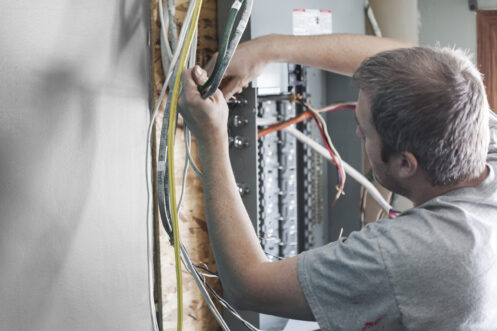If you’re experiencing a circuit breaker that keeps tripping, you’re not alone. This is a common problem that many homeowners face, and it can be frustrating and even dangerous if left unchecked. Knowing what to do when your circuit breaker keeps tripping can help you avoid potential hazards and ensure that your home’s electrical system is functioning properly.
First and foremost, it’s important to understand what a circuit breaker is and how it works. A circuit breaker is a safety device that protects your home’s electrical system from overloading and overheating. When too much electricity flows through a circuit, the breaker “trips” and shuts off power to that circuit. This prevents damage to your home’s electrical system and reduces the risk of electrical fires. However, if your circuit breaker keeps tripping repeatedly, it could be a sign of a more serious issue that requires professional attention.
Understanding Circuit Breakers
How Circuit Breakers Work
Circuit breakers are electrical safety devices that protect your home or business from electrical overloads and short circuits. They work by automatically shutting off the flow of electricity when there is an excessive current. This prevents overheating and potential fires.
A circuit breaker consists of two parts: a switch and a trip mechanism. When the current flowing through the circuit exceeds the rated limit, the trip mechanism activates, and the switch turns off. This interrupts the flow of electricity and prevents damage to the electrical system.
Common Reasons for Tripping
Overloaded circuit: When too many electrical devices are connected to a single circuit, it can overload the circuit and cause the breaker to trip.
Short circuit: A short circuit occurs when a hot wire comes into contact with a neutral wire or ground wire. This can cause a sudden surge of electricity, which can trip the breaker.
Ground fault: A ground fault occurs when a hot wire comes into contact with a ground wire or a metal box. This can cause a surge of electricity, which can trip the breaker.
Old or faulty breaker: Over time, circuit breakers can wear out or become faulty. This can cause them to trip more frequently or fail to trip when needed.
It’s important to address the cause of a tripped circuit breaker to prevent further damage to your electrical system. If you’re unsure about how to troubleshoot the issue, it’s best to consult a licensed electrician.
Immediate Steps After Tripping
If your circuit breaker has tripped, it’s important to take immediate steps to ensure your safety and prevent further damage to your electrical system. Here are the steps you should take:
Safety First
Before you do anything else, turn off all appliances and devices connected to the tripped circuit. This will prevent any electrical surges or fires from occurring. You should also avoid touching any electrical components or wires, and wear rubber-soled shoes to reduce the risk of electrical shock.
Resetting the Circuit Breaker
Once you have ensured your safety, you can attempt to reset the circuit breaker. To do this, follow these steps:
1. Locate the tripped circuit breaker in your electrical panel.
2. Push the breaker switch to the “off” position. You should hear a click when it reaches the off position.
3. Wait a few seconds, then push the switch back to the “on” position. You should feel it snap into place.
4. If the circuit breaker trips again immediately, it may indicate a more serious problem. You should stop and contact a licensed electrician.
Remember, if you are unsure about any of these steps or feel uncomfortable working with electricity, it is always best to call a professional. Taking the proper precautions and following these steps can help you quickly and safely resolve a tripped circuit breaker.
Troubleshooting Persistent Issues
If your circuit breaker keeps tripping, it could be due to persistent issues that require some troubleshooting. Here are some steps you can take to identify and fix the problem.
Identify Overloaded Circuits
Overloaded circuits are a common cause of tripping circuit breakers. An overloaded circuit occurs when too many electrical devices are connected to a single circuit, causing it to exceed its capacity. To identify an overloaded circuit, you can use a clamp meter to measure the current flowing through the circuit. If the current is higher than the circuit’s capacity, you need to redistribute the devices to other circuits or add a new circuit to your electrical panel.
Check for Faulty Appliances
Faulty appliances can also cause circuit breakers to trip. To identify a faulty appliance, unplug all the devices connected to the circuit and reset the breaker. Then, plug in one device at a time and turn it on. If the breaker trips when you turn on a specific device, it’s likely that the device is faulty and needs to be repaired or replaced.
Inspect for Short Circuits
Short circuits occur when a hot wire touches a neutral wire or a ground wire, causing a surge of electricity that trips the breaker. To identify a short circuit, you can use a multimeter to test the circuit for continuity. If it shows continuity between the hot wire and the neutral wire or ground wire, you have a short circuit that needs to be fixed by a licensed electrician.
By following these troubleshooting steps, you can identify and fix persistent issues that cause your circuit breaker to keep tripping. Always exercise caution when working with electricity, and consult a professional if you need clarification on any aspect of your electrical system.
When to Call a Professional
If you have tried all the troubleshooting steps and your circuit breaker keeps tripping, it may be time to call a professional electrician. Here are some signs that indicate you should seek professional help:
Your circuit breaker keeps tripping repeatedly, despite your best efforts to fix the problem.
You notice burning smells or see smoke coming from your electrical panel.
You see signs of damage to your electrical wiring or outlets, such as frayed wires, loose connections, or blackened areas.
You have an older home with outdated electrical wiring that may not be up to code.
Attempting to fix electrical problems on your own can be dangerous and may result in further damage to your home or injury to yourself. A licensed electrician has the knowledge and expertise to diagnose and repair electrical problems safely and efficiently.
When selecting an electrician, be sure to choose someone who is licensed, insured, and experienced in handling the specific electrical issues you are facing. You may also want to consider getting multiple quotes to ensure you are getting a fair price for the services you need.
Reach Out to Us
If you’re experiencing persistent tripping, don’t hesitate to reach out to [company_name] for professional electrical services. Our experienced technicians can diagnose the problem and provide reliable solutions to keep your home or business safe and powered up. Your safety and the safety of your home are our top priorities.


